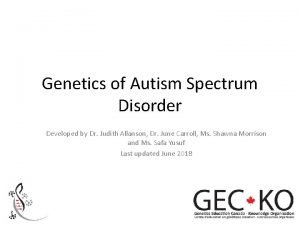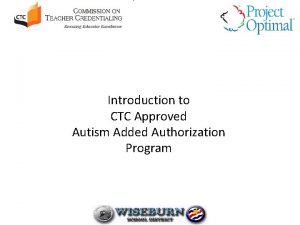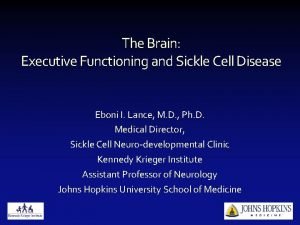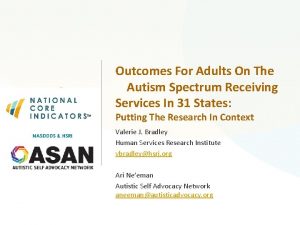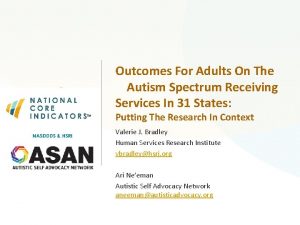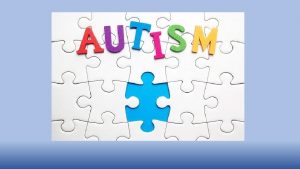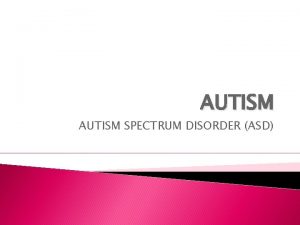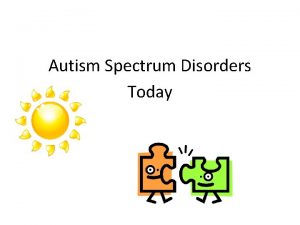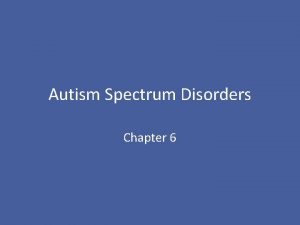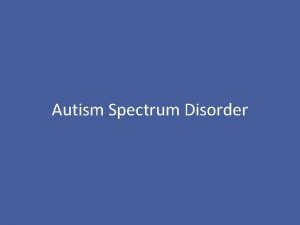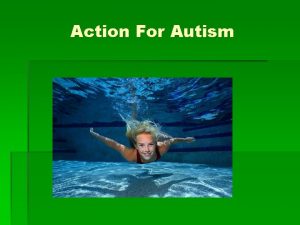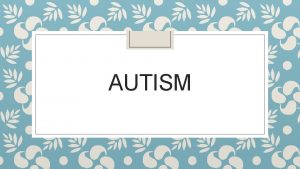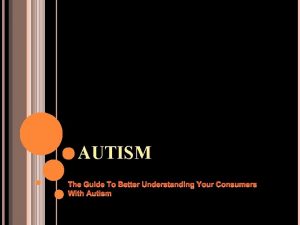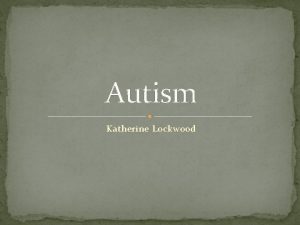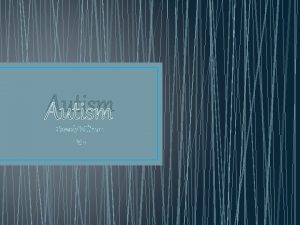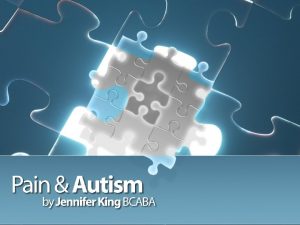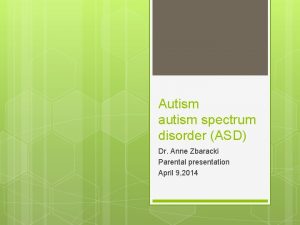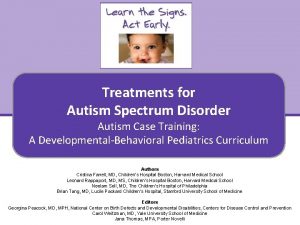Outcomes For Adults On The Autism Spectrum Receiving

































- Slides: 33

Outcomes For Adults On The Autism Spectrum Receiving Services In 31 States: Putting The Research In Context Valerie J. Bradley Human Services Research Institute vbradley@hsri. org Ari Ne’eman Autistic Self Advocacy Network aneeman@autisticadvocacy. org

Terminology Preferences • Within the autism and Autistic communities, a wide variety of different linguistic preferences exist, with many individuals on the autism spectrum preferring the use of “identity-first” language rather than “person-first”. • Within this presentation, we will alternate between “person on the autism spectrum” and “autistic person”. • See http: //autisticadvocacy. org/home/about-asan/identity -first-language/ for more details.

Overview • Background § Autism in the USA • Prevalence/Characteristics • Services and Supports • Differential outcomes § What is National Core Indicators? • What do NCI data show about outcomes for autistic adults? • Policy Recommendations • Discussion

What Do We Know About People with Autism?

Autism Spectrum Disorder • Prevalence estimates of ASD are rising § Autistic people represent higher percentage of population than previously recognized. • Proportion of Autistic people with co-occurring intellectual disabilities (ID), by some estimate, is as high as 60% § However, some question the applicability of standardized tests for people with ASD.

Autism and State I/DD Service Systems • In some states, Autistic people are eligible for ID/DD services. § Often due to concomitant ID diagnosis, functional limitations, and/or state eligibility criteria that goes beyond ID § Recently, some states adopting “autism waivers. ” • However, the number of individuals enrolled is small. § Hewitt et al. (2012) estimated that only 8. 1% of the individuals receiving public I/DD services have been assigned an ASD diagnosis.

Autism and State I/DD Service Systems • DSM-5 eliminated the separate categories of autism disorder including pervasive developmental disorder, Asperger's syndrome, childhood disintegrative disorder and autistic disorder. Instead there will be one diagnostic category for the autism spectrum. • To be classified on the spectrum, individuals must show deficits in social communication impairment, and restricted interests/repetitive behaviors • These changes may result in increased access to services for those who may have met the functional eligibility criteria for waiver services but have been excluded because of their presenting diagnosis

Sweeping Changes Over Past Several Decades • • • Developmental Disabilities Assistance and Bill of Rights Act Americans with Disabilities Act (ADA) Individuals with Disabilities Education Act (IDEA) Rehabilitation Act of 1973. . . Led to growth of community-based settings for people with disabilities § Goal: aim to encourage “full inclusion and integration in the economic, political, social, cultural and educational mainstream of American society”

Autistic Individuals Lag Behind • Autistic people do not appear to have benefited to the same extent as those without autism. Research has shown: § Poorer adult life outcomes in areas such as: • Independent living • Community inclusion § Teens with ASD fared worse than other students with intellectual disabilities. • physical well-being, social support and psychological well-being

National Core Indicators What do NCI data show regarding outcomes for Autistic adults receiving public services?

What is NATIONAL CORE INDICATORS (NCI)? • NASDDDS, HSRI & State DD Directors § Multi-state collaboration § Launched in 1997 in 13 participating states – now in 45 states (including DC) and 22 sub-state areas • Goal: Measure performance of public systems for people with intellectual and developmental disabilities by looking at outcomes § Help state DD systems assess performance by benchmarking, comparing to other states § Domains: employment, community inclusion, choice, rights, health, safety, relationships, service satisfaction etc.

NCI State Participation 2015 -16

Data Source: Adult Consumer Survey • Standardized, face-to-face interview with a sample of individuals receiving services § Background Information - includes health information § Section I (no proxies allowed) § Section II (proxies allowed) • No pre-screening procedures • Conducted with adults only (18 and over) receiving at least one service in addition to case management • Section I and Section II together take 50 minutes (on average)

Data for This Presentation • NCI Consumer Survey Data, 2013 -14 § 30 states, DC, and 1 sub-state entity § 15, 525 individual surveys • Subsample identified: § Diagnosis of “Autism Spectrum Disorder (i. e. , Autism, Asperger Syndrome, Pervasive Developmental Disorder)” identified in background § Information on diagnoses taken from agency records § The total number of records indicating the presence of ASD was 2, 277

National Core Indicators What do NCI data show about Autistic adults receiving state I/DD services?

Demographics Gender 100% 80% 75% Level of ID 25% of those who reported ASD Diagnosis are female N/A- No ID label 23% 18% 13% Severe ID 40% 12% Profound ID 25% 5% 3% Unspecified level of ID 20% 6% 4% ID level unknown 0% Male No ASD Diagnosis (N=11, 170) Female • p<=. 001 35% 27% 29% Moderate ID 45% ASD Diagnosis (N=2, 255) 10% Mild ID 55% 60% 4% 0% 10% 20% ASD Diagnosis (N=2, 231) No ASD Diagnosis (N=11, 122) 30% 40%

Demographics: Age and Residence Percent of Respondents With/Without ASD Diagnosis Between Ages 18 -22 Age 18 -22: Percent of those With/Without ASD Diagnosis and Residence Type 2% 2% 100% Institution 80% Community Based Residence 12% 11% 8% 5% Independent Home/Apt 60% 71% 78% Parent/Relative's home 40% 6% 5% Foster Care/Host Home 21% Other 20% 5% 0% ASD Diagnosis No ASD Diagnosis 2% 1% 0% 20% 40% 60% 80% 100% ASD Diagnosis No ASD Diagnosis Average of respondents with ASD Diagnosis: 33. 5 Average of respondents without ASD Diagnosis: 44. 9

More Individuals with Autism Have a Mental Health Diagnoses Proportions of Adult Consumer Survey respondents with reported mental health diagnoses, behavior challenges, by ASD diagnosis 100% 49% of those with ASD have behavior challenges 80% 60% 49% 35% 31% 38% 23% 28% 20% 0% • ***p ≤. 001 ***Mood Disorder ***Anxiety Disorder ASD Diagnosis ***Behavior Challenges No ASD Diagnosis Autistic individuals were far more likely to be reported as receiving medications for anxiety, mood, behavior or psychotic disorders: ASD Diagnosis: 72% No ASD Diagnosis: 52%

More Individuals with Autism Have Guardianship status of Adult Consumer Survey respondents by ASD diagnosis Chart Title 70% 63% 53% 47% 35% 18% 0% ASD Diagnosis (N=2, 196) • ***p≤. 001 National Core Indicators (NCI) No ASD Diagnosis (N=10, 944) Independent of Guardianship Limited or Full Guardianship

People with Autism Less Likely to Live in Their Own Home/Apartment Chart Title 100% • 22% of those with no ASD diagnosis live in their own home or apartment. 10% of those with an ASD diagnosis live in their own home or apartment 80% 60% 45% 40% 32% 30% 31% 22% 20% 10% 8% 8% 4% 4% 3% 4% 0% Institution Community-Based Own Home or Apartment ASD Diagnosis (N=2, 227) Parent or Relative's Home Foster Care or Host Home No ASD Diagnosis (N=11, 014) Other

Fewer People With ASD Use Words to Speak 100% 77% 80% Chart Title 30% of those with ASD diagnosis communicate primarily using gestures/body language 62% 60% 40% 30% 17% 20% 3% 2% 2% 1% 3% 3% 0% Spoken Gestures/Body Language ASD Diagnosis (N=2, 246) Sign Language/Finger Spelling Communication Aid/Device No ASD Diagnosis (N=11, 142) Other

Autistic Adults Are Less Likely to be Employed Chart Title 100% 80% Those with ASD diagnosis were more likely to be in unpaid activities and less likely to have paid jobs/activities 60% 46% 44% 40% 28% 20% 13% 26% 25% 19% 16% 0% ***Paid, Community-Based ***Unpaid, Community. Job Based Activity *p ≤. 05 ***p ≤. 001 ASD Diagnosis ***Paid, Facility-Based Job No ASD Diagnosis *Unpaid, Facility-Based Activity

Autistic Adults Are Less Likely to Make Choices About Their Lives Chart Title 100% 80% 89% 91% 82% 68% 87% 65% 58% 49% 47% 38% 62% 60% 54% 60% 40% 83% 33% 20% 0% ***Chose Home • ***p≤. 001 ***Chose Staff ***Chooses Roommates Daily Schedule ASD Diagnosis ***Chooses ***Chose Day ***Chooses ***Chose Case Free Time Activity What to Buy Manager No ASD Diagnosis Of those with ASD Diagnosis: using a self directed supports option: 14% Of those with No ASD Diagnosis: using a self directed supports option: 8%

Autistics Adults Less Likely to Have Friends Chart Title 100% 80% 73% 77% 76% 80% 75% 80% 60% 40% 20% 0% Has Friend • ***p≤. 001 National Core Indicators (NCI) Has a Best Friend ASD Diagnosis No ASD Diagnosis Able to See Friends When Wanted

Autistics Adults Less Likely to Have Friends Chart Title 100% 75% 73% 77% 76% 80% 75% 80% 50% 25% 0% Has Friend • ***p≤. 001 National Core Indicators (NCI) Has a Best Friend ASD Diagnosis No ASD Diagnosis Able to See Friends When Wanted

What are the Policy Initiatives that Will Enhance Outcomes for Autistic Adults?

Key Policy Issues • Research • Long Term Services and Supports • Housing • Employment • Legal Autonomy and Supported Decisionmaking 27

Research • Significant disparities in autism research funding allocation • In 2010, of NIH’s $217 M in Autism Research, only 1. 5% went towards adults and only 2. 45% towards services research • Need for Participatory Action Research models 28

Long Term Services and Supports • CMS HCBS Settings Rule • Significant Gap for Autistic people who do not meet institutional Lo. C • Emerging use of state 1915 i state plan authority to meet need for this population • Family Support 29

Housing • Settings rule encouraging a shift towards supported living, shared living models; • States need to establish rental subsidy programs to make supported living viable; • Congregate models frequently replicate the dynamics of an institution; 30

Employment • Five states (VT, MA, OR, RI, NY) have or are committing to phasing out sheltered work; • Growing Olmstead litigation around integrated employment; • Integrated Day Services often key to the employment discussion; • S. 1604, the Transition to Independence Act 31

Legal Autonomy and SDM • Article 12 of the UN CRPD • Texas recently became first state to adopt SDM Law; • ASAN Model Legislation on Healthcare Supported Decision-Making • Liability issues remain to be sorted out, especially in financial and healthcare SDM 32

What did they say?
 Cdd disorder
Cdd disorder Puberty and autism spectrum disorders
Puberty and autism spectrum disorders Is autism genetic
Is autism genetic Autism spectrum disorders added authorization
Autism spectrum disorders added authorization Autism spectrum disorder adhd
Autism spectrum disorder adhd Types of autism spectrum disorder dsm 5
Types of autism spectrum disorder dsm 5 Copper orbital diagram
Copper orbital diagram Absorption spectrum
Absorption spectrum Offentlig förvaltning
Offentlig förvaltning Etik och ledarskap etisk kod för chefer
Etik och ledarskap etisk kod för chefer Datorkunskap för nybörjare
Datorkunskap för nybörjare Antikt plagg i rom
Antikt plagg i rom Rita perspektiv
Rita perspektiv Ministerstyre för och nackdelar
Ministerstyre för och nackdelar Claes martinsson
Claes martinsson Sju principer för tillitsbaserad styrning
Sju principer för tillitsbaserad styrning Plats för toran ark
Plats för toran ark Nationell inriktning för artificiell intelligens
Nationell inriktning för artificiell intelligens Cirkelkomposition exempel
Cirkelkomposition exempel Nyckelkompetenser för livslångt lärande
Nyckelkompetenser för livslångt lärande Modell för handledningsprocess
Modell för handledningsprocess Tidbok för yrkesförare
Tidbok för yrkesförare Orubbliga rättigheter
Orubbliga rättigheter Stål för stötfångarsystem
Stål för stötfångarsystem Jätte råtta
Jätte råtta Särskild löneskatt för pensionskostnader
Särskild löneskatt för pensionskostnader Verktyg för automatisering av utbetalningar
Verktyg för automatisering av utbetalningar Texter för hinduer tantra
Texter för hinduer tantra Urban torhamn
Urban torhamn Aktiv expektans
Aktiv expektans Ro i rom pax
Ro i rom pax Stig kerman
Stig kerman Strategi för svensk viltförvaltning
Strategi för svensk viltförvaltning Verksamhetsanalys exempel
Verksamhetsanalys exempel


